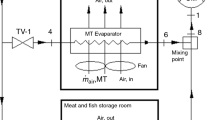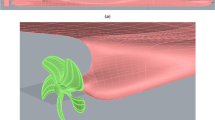Abstract
The application of recently introduced IMO regulations for reduction of CO2 gaseous emissions as well as the initiatives for greener shipping rendered the efforts for improving on board energy system performance to be of high priority. This study focuses on the investigation of the on board operation of the combined sea/freshwater cooling system of a merchant ship. The detailed model of a cooling system is presented based on the energy and mass conservation laws. The simulation input data include the system geometry and arrangement, the operational characteristics of cooling pumps, the control scenarios for the system valves as well as data for calculating the pipes friction and minor losses coefficients, wherefrom the system performance parameters can be calculated. The cooling system energy consumption was estimated considering a typical annual ship operational profile. Two cases were investigated: first, a conventional case of controlling the seawater and freshwater temperatures using three-way valves and, second, a more sophisticated case of installing variable speed motors for driving the system pumps. The obtained results are compared in terms of annual power consumption leading to conclusions about the system performance. The developed models can be used as an assessment tool for improving the shipboard power demand early in the design stage as well as during operation.








Similar content being viewed by others
Abbreviations
- D/E:
-
Diesel engine
- D/G:
-
Diesel/electric generator
- FW:
-
Freshwater
- HT:
-
High temperature
- JW:
-
Jacket water
- LT:
-
Low temperature
- MCR:
-
Maximum continuous rating
- M/E:
-
Main engine
- SW:
-
Seawater
- VFD:
-
Variable frequency drive
- a, b, c :
-
Constants (−)
- A :
-
Pipe cross-sectional area (m2)
- c p :
-
Specific heat at constant pressure (J/kg K)
- D :
-
Pipe hydraulic diameter (m)
- e/D:
-
Relative roughness (−)
- E :
-
Energy (kWh)
- f :
-
Friction factor (−)
- g :
-
Gravitational acceleration (m/s2)
- h :
-
Head (m)
- H :
-
Operating hours (h)
- K :
-
Loss coefficient (−)
- L :
-
Pipe length (m)
- N :
-
Rotational speed (r/min)
- P :
-
Power (W)
- POT:
-
Percentage of time (%)
- \(\dot{Q}\) :
-
Transferred heat rate (W)
- Re :
-
Reynolds number (−)
- T :
-
Temperature (K)
- \(\dot{V}\) :
-
Volumetric flow rate (m3/s)
- z :
-
Elevation (m)
- Δ:
-
Difference
- η :
-
Efficiency (−)
- ρ :
-
Fluid density (kg/m3)
- C:
-
Cold side
- CC:
-
Central cooler
- d:
-
Drive
- hot:
-
Hot side
- HE:
-
Heat exchanger
- HTFW:
-
High-temperature freshwater
- in:
-
Inlet
- JW:
-
Jacket water
- LT:
-
Low temperature
- m:
-
Motor
- ME:
-
Main engine
- o:
-
Outlet
- p:
-
Pump
References
IMO (2011) Resolution MEPC.203(62), amendments to the annex of the protocol of 1997 to amend the international convention for the prevention of pollution from ships, 1973, as modified by the protocol of 1978 relating thereto (inclusion of regulations on energy efficiency for ships in MARPOL Annex VI), MEPC 62/24/Add.1. International Maritime Organization, London
ABB (2010) Energy efficiency solutions-Simple steps to reduce fuel consumption and your environmental footprint. ABB Oy Marine, Helsinki, Finland. https://library.e.abb.com/public/27d7d3c1812938dfc1257c0000488d21/EnergyEfficiencySolutions.pdf. Accessed 1 June 2016
Su CL, Chung WL, Yu KT (2013) An energy-savings evaluation method for variable-frequency-drive applications on ship central cooling systems. IEEE Trans Ind Appl 50(2):1286–1294
Räsänen J-E, Schreiber EW (2012) Using variable frequency drives (VFD) to save energy and reduce emissions in new builds and existing ships. ABB Marine & Cranes Service, Helsinki, Finland
Mrakovcic T, Medica V, Skific N (2004) Numerical modelling of an engine cooling system. J Mech Eng 50(2):104–114
Hansen M, Stoustrup J, Bendtsen J (2013) Modeling and control of a single-phase marine cooling system. Control Eng Pract 21:1726–1734
DNV GL SE (2015) Rules for classification and construction, I-1.2. Hamburg, Germany. http://www.gl-group.com/infoServices/rules/pdfs/gl_i-1-2_e.pdf. Accessed 1 June 2016
Haaland SE (1983) Simple and explicit formulas for the friction factor in turbulent flow. J Fluids Eng 103(5):89–90
Brkic D (2011) Review of explicit approximations to the Colebrook relation for flow friction. J Petrol Sci Eng 77:34–48
Peters MS, Timmerhais K, West RE (2003) Plant design and economics for chemical engineers, 5th edn. McGraw Hill, NY
Shah RK, Sekulic DP (2003) Fundamentals of heat exchanger design. Wiley, London
Karassik I, Messina J, Cooper P, Heald C (2001) Pump handbook, 3rd edn. McGraw-Hill, NY
US Department of Energy. (1991). Fact Sheet: Determining Electric Motor Load and Efficiency. Motor Challenge Program, Technical Report
Athanasiadis N (1989) Hydrodynamic machinery. NTUA, Athens
Lobanoff VS, Ross RR (1985) Centrifugal pumps design and application. Gulf Publishing, Houston
The Society of Naval Architects and Marine Engineers (SNAME) (1990) Marine diesel power plant practices. T & R Bulletin no. 3-49, Jersey City, NJ, USA
Baldi F, Bengtsson S, Andersson A (2013) The influence of propulsion system design on the carbon footprint of different marine fuels. Low carbon shipping conference, London
MAN Diesel & Turbo (2010) MAN B&W S50MC-C8-TII project guide camshaft controlled two-stroke engines. Copenhagen, Denmark. http://marine.man.eu/applications/projectguides/2stroke/content/printed/s50mcc8.pdf. Accessed 1 June 2016
MAN Diesel & Turbo (2015) L16/24 project guide—marine four-stroke GenSet compliant with tier II. Augsburg, Germany. http://marine.man.eu/applications/projectguides/4stroke/manualcontent/PG_M-II_L1624.pdf. Accessed 1 June 2016
Acknowledgments
The authors gratefully acknowledge the financial support of the European Commission through the research project JOULES (http://www.joules-project.eu), which is jointly funded by the 7th Framework Programme and the industry, for the work reported in this paper.
Author information
Authors and Affiliations
Corresponding author
About this article
Cite this article
Theotokatos, G., Sfakianakis, K. & Vassalos, D. Investigation of ship cooling system operation for improving energy efficiency. J Mar Sci Technol 22, 38–50 (2017). https://doi.org/10.1007/s00773-016-0395-9
Received:
Accepted:
Published:
Issue Date:
DOI: https://doi.org/10.1007/s00773-016-0395-9




